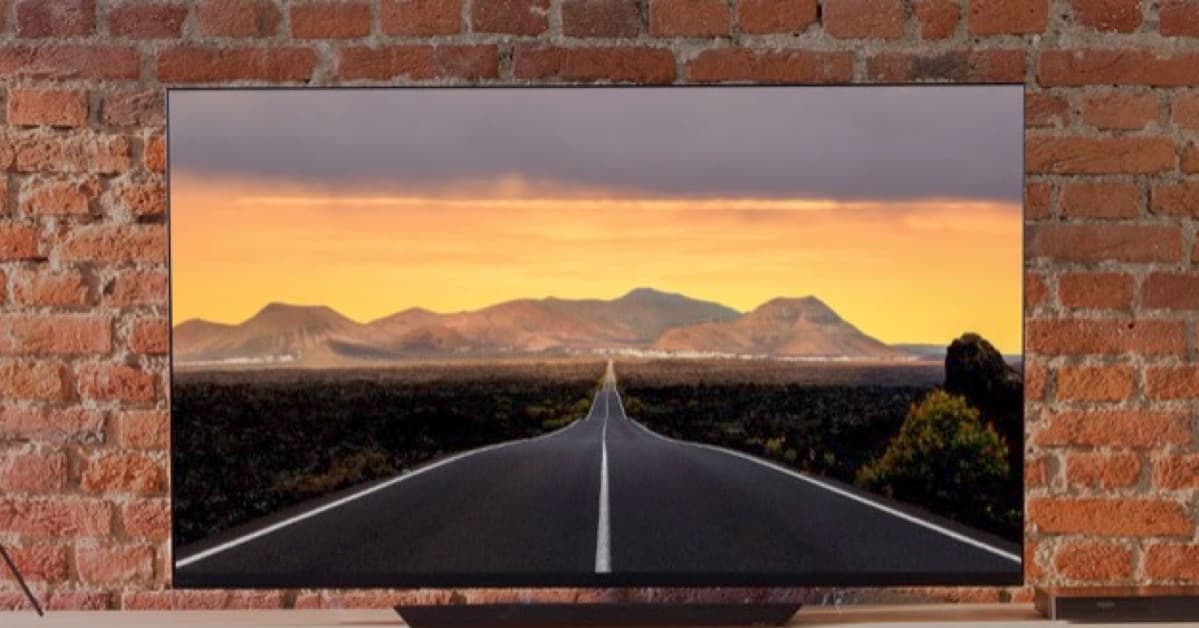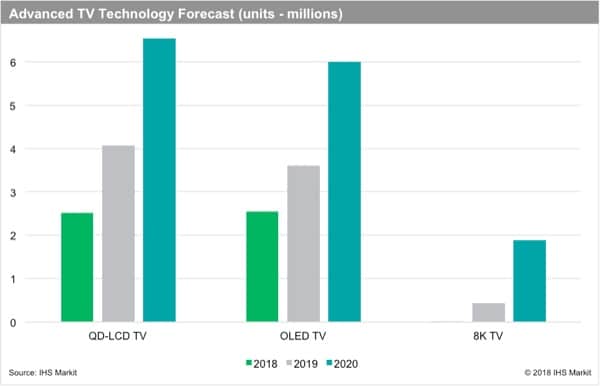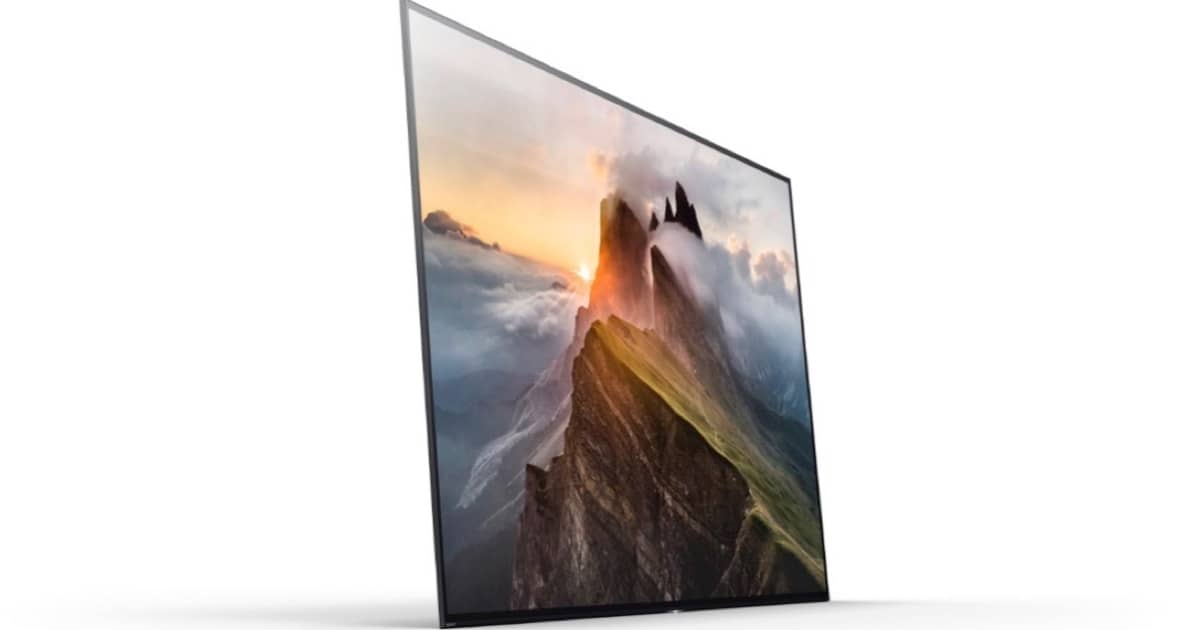4K/UHD TVs are no longer a rarity and are now emerging as mainstream. According to IHS, of all the TVs sold in 2019, half will be 4K/UHD.

A Report from IHS
Paul Gagnon at IHS Markit has recently published a report: “Advanced TV technologies poised for growth.”
“Of the 226 million TVs expected to ship in 2019, more than half will be ultra-high-definition (UHD) models, the majority of which are 4K. However, 8K TVs from major global TV brands will launch toward the end of 2018, kicking off the next wave of resolution transition.”
Analyst Gagnon points out that growth in the TV market is typically due to decreasing, attractive pricing. That’s based on economies of scale, but as TV makers do that, competition heats up and profits can still be squeezed.
However, this growth through price compression has a negative effect on profits, so TV brands are actively looking for more growth from advanced TV models to improve earnings. [Emphasis mine.]
By “advanced,” IHS means OLED, Quantum Dot (QD) technology, and 8K/UHD. For a primer on Quantum Dots, see: “A Primer: LCDs, OLEDs, Quantum Dots and MicroLEDs.” The tl;dr version is that Quantum Dot TVs still use backlit LCDs and are still inferior to OLED when it comes to black-levels. Note, however, that all modern 4K/UHD TVs offer HDR, at the minimum HDR10.
4K/HDR Growth
While there has been a slight decline in unit shipments in 2017, the forecast is for 3.6 percent growth in 2019. That’s probably due to several factors. First HDR technology is maturing, more widely adopted and better understood by consumers. For a great primer, see:
[A Tutorial: High Dynamic Range (HDR) for 4K TVs]
Second, the amount of 4K/UHD content available from streaming providers, like Apple, Amazon and Netflix has good market awareness and is becoming mainstream. And finally, TV makers no longer find it profitable to manufacture 1080p/HD TVs larger than 49 inches. So if the customer wants something bigger, it’ll have to be 4K/UHD.
Advanced 4K/UHD TVs with OLED or Quantum Dot displays are now popular in the 55-inch range [see below] and run about US$1,000 more than conventional 4K/UHD technology, using LED/LCDs. The sweet spot there is 65-inches.
For a good round-up of the best OLED, Quantum Dot, and LCD/LED TVs in the autumn of 2018, see: “The best 4K TVs of 2018.”
What About 8K/UHD?
IHS Markit forecasts that the 8K TV market will grow from less than 20,000 units in 2018 to more than 430,000 in 2019 — eventually approaching 2 million units by 2020. All of this growth will be centered on 60-inch and larger screen sizes, with 65-inch TVs accounting for more than half of the volume.
Due to the well-known Retina effect, it doesn’t make sense to build an 8K/UHD TV less than 65 inches in size. As for how fast 8K/UHD will overtake 4K/UHD in sales, that’s a complex question. Even in 2020, the number of 8K/UHD TVs sold will remain a small fraction of all 4K/UHD TVs sold, according to IHS. (See chart.)

Finally, the IHS report has interesting observations to make about the emergence of OLED, mostly notably from LG and Sony and Quantum Dots, most notably from Samsung.
OLED TV is expected to grow more than 40 percent in 2019, rising to 3.6 million units. This growth is in line with previous forecasts, because demand is essentially matching industry production capacity. The size mix still favors 55-inch TVs, based on current prices, but it will transition to mostly 65-inch TVs by 2020, when new production capacity is optimized for larger screen sizes, and when substantial growth is expected in the OLED TV category.
Quantum dot LCD TV shipments are now forecast to exceed 4 million units in 2019, based on more aggressive pricing and the introduction of transitional quantum-dot-equipped LCD TV models.’The high-end prices of non-QD-equipped LCD TV models and the prices of the low end QD-equipped LCD TV models have moved closer together,’ [Paul] Gagnon said. ‘This extension of the quantum dot LCD TV lineup into more moderate price ranges effectively reduces the quantum dot premium to less than 100 percent at mid-range sizes, opening up the category to a larger addressable market of consumers.’
Outlook
It appears that the TV industry has been successful in selling customers on the idea of 4K/UHD thanks to the dramatic picture enhancements of HDR and the relatively good availability of streaming 4K/UHD content.
While the industry will eventually find it unprofitable to manufacture even 4K/UHD TVs — preferring to move production to 8K/UHD, buyer financial resistance, the lack of a new, dramatic motivating factor such as HDR, and the fact that the US broadcast system will remain at HD for many more years means that we likely won’t be looking a 8K/UHD as mainstream for at least another decade.

First saw 4k at Frys a couple years ago and immediately was struck by the color gamut and contrast and that had ZERO to do with the source 720p, 1080p, Just for that alone it was obvious 1080p is obsolete. This site seems reticent in adoption of new tech- quantum dots; OLED, flexible screens, styli, AR – I could point to many old articles where these now common standards were minimized here only to eat crow later. A quick check shows 42″ 4k smart TVs available for less than $300 – I don’t know about you but I can always use a few more big-ass monitors to plug into the Mac Pros and blast almost 4000 pixels – compared to 1024 pixels – no brainer. Movies and vids are being shot in 8k today so don’t be shocked when that standard becomes a standard in a few years. At least there is a tangible improvement as opposed to Apple’s blatant yearly scam of a “new” iPhone. Blame your local reps you voted for for not pressuring Comcast, Spectrum et al to stop marketing “HD” like it’s a big deal when 4k is all over S Asia like yesterday’s news. Only here in the USA do we get ripped off by paying for different speeds…But until the drones demand that our providers STOP – and give everybody the latest fastest speeds – then we – you- me deserve what we get. BOHICA. I ditched cable years ago (get everything from foreign websites-all sports and cable)- Spectrum is beggin me – and I tell them to F-Off.
Until I can get better quality programming, code for things that I like, I will stick with my 256K receiver.